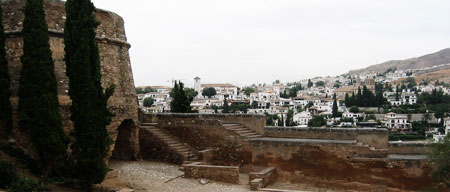Home > Study in Spain > City Guide > Granada
Granada City Guide
- Places of Interest
- Maps
- Getting to
- Getting around the city
With the lush plains and snow-capped mountains of the Sierra Nevada as its backdrop, this historic city has a suitably dramatic setting in the heart of Andalusia. It is known worldwide for the sumptuous palaces of La Alhambra, which is Spain's most visited attraction and without doubt a true masterpiece of architecture. Not quite European, characterized by Moorish architecture and the gypsy "Albaicín" quarter, yet not quite Oriental, with its Renaissance cathedral and traditional Andalusian cuisine and tapas culture, Granada is one of the truly unique cities of the world. It is a city packed with history and yet maintains a modern edge. It's known for its lively nightlife, its large portions of "tapas" and its friendly residents. Lying in the foothills of the Sierra Nevada, it is still only 45 minutes from the Costa Tropical. There's truly something for everyone in Granada! Just outside the city there are plenty of opportunities to get in touch with nature and discover the small, typically Spanish villages that are scattered about the Andalusian region
Places of Interest
Alhambra
Granada's most famous landmark and one of the world's most exquisite examples of Islamic Golden Age art and architecture, the Alhambra palace, is a UNESCO World Heritage Site which dominates Granada's skyline! This enormous palace of 740 meters in length by 205 meters wide, flanked with 13 towers was a finalist for the "7 New wonders of the World". When Granada was conquered, Queen Isabella and King Ferdinand instructed that parts of the palace were knocked down and replaced with the Renaissance architecture that still stands there today. The palace is equally stunning from the inside with elegant columns towering effortlessly over airy and spacious rooms. The intricate geometrical patterns and beautiful calligraphy that decorate the rooms are strikingly impressive. In particular, you should see Patio de los Lones, Sala de los Abencenrajes and Peinador de la Reina. The Alameda de la Alhambra, which is the park surrounding the fortress is beautifully dotted with rose bushes and orange trees, and the dense wood of English elms is home to dozens of tuneful nightingales.
Generalife
The Generalife, located just a short walk from the Alhambra, was the summer palace and gardens of the Nasrid dynasty. It was originally linked to the Alhambra by a covered walkway at the Patio de la Acequia and the Jardín de la Sultana. Today, the beautiful, serene gardens are riddled with narrow walkways made of a mosaic of black pebbles from the River Geríl and white pebbles from the River Darro. Bright flowerbeds, trickling fountains and elegant pavilions frame a central water-garden and pool.
Albaicín
Declared a World Heritage Site in 1984, the Albacín is the old Muslim quarter and has maintained its Moorish medieval winding, cobbled streets and charming houses. El Albaicín sits on the hill opposite the Alhambra, separated from it by a deep ravine through which flows the River Darro. Many tourists make the trip here simply to marvel at the dramatic panoramas of the palace. A wander through the maze of twisting back streets will reveal the remains of Arab baths, Granada's archeological museum, the quaint Iglésia de San Salvador and dozens of delightful restaurants specializing in North African cuisine.
Sacromonte
Sacromonte is the famous Gitano (gypsy) neighborhood in Granada. It was the home of thousands of gypsies who fled persecution all over Europe during medieval times. It was here that the Zambra Gitano, which eventually became the flamenco, originated. The gitanos have occupied this area of the city since the 18th century. Today, you can visit the caves which were inhabited by the gypsies and converted into houses; a few are still lived in today. If you're looking for traditional music and merriment, Sacromonte is the place to come as dozens of bars put on flamenco shows each evening.
The Cathedral
Designed at the peak of the Spanish Renaissance, Granada's cathedral took 181 years to build, allowing it to be influenced by Gothic, Renaissance and Baroque styles and consequently it is a unique fusion of architectural styles. Unlike many cathedrals, it is light and airy, making it most pleasant to visit on a sunny day when the stained-glass windows are at their most spectacular. The cathedral was built on the orders of Queen Isabella, undoubtedly to prove that her conquest of Granada was complete.
Parque de las Ciencias
For culture of a different kind, visit the city's science park. With over 270 interactive exhibitions, a planetarium, a tropical butterfly house, an observation tower, an astronomy garden and even an oil mill, this "museum" is an absolute must for an understanding of some of the most fascinating scientific phenomena! The main activities are divided between two buildings, which are connected by a large glass hall.
El Museo de la Alhambra
Located in the Alhambra itself, in the palace of Carlos V, this museum features some outstanding examples of Hispano-Moorish art from the 9th century all the way through to the 16th century! The works featured are made from all kinds of material such as wood, ceramics, plaster and metal, ensuring each piece is unique with its own story to tell.
Casa-Museo de Federico García Lorca
The house of one's of Spain's most famous and controversial modern writers has been converted into a museum. You can take 30 minute tours of this fascinating abode, including his bedroom and piano room. Part of the house has been turned into an exhibition hall, which contains some of his drawings, photos and manuscripts.
Maps
Getting to Granada
By plane
The nearest international airport is located 16km west of the city, near a small town called Sante Fé. Planes from here mainly serve national flights from Madrid and Barcelona, however a number of low cost airlines have started to fly here from other European destinations. There is a bus service from the airport, which runs in time with arrivals and departures. It goes from outside Arrivals, the journey time is 45 minutes and it costs 3€. A taxi costs approximately 17€ to the city centre.
By train
Trains take four and a half hours from Madrid and go several times each day, costing 65€ for a single journey, check out www.renfe.es for more details.
By bus
The buses go about every hour from the Méndez Alvaro station (Estación del sur) in Madrid. If there is a busy day, for example before or after a fiesta they put on more buses according to demand. The usual thing (if you haven't bought tickets in advance) is just to go to the bus station and get on the next available bus. You would be unlucky if you have to wait longer than 2 hours for a bus. Try the Enatcar window. It takes about 5 hours from Madrid to Granada and costs around 16€.
By car
The Spanish road network has improved a lot in the last 20 years and there are good roads to all other Spanish cities. It takes about 5 hours to Madrid, 11 hours to Barcelona, and 90 minutes to Malaga.
Getting around the city
Granada's city center is compact enough to get about easily on foot. The majority of the historical sites, such as the Cathedral and the Alhambra are located within walking distance as are all the night time hot-spots. However, an efficient urban bus system serves the city center and the suburbs, providing a reliable and economic means of getting around, especially if you want to venture into the hills towards Sacromonte. A single journey costs approximately 1€, although a Bonobus pass can be a more economical purchase should you plan on using the bus service frequently, this costs around €5 for 8 trips and €34 for an unlimited monthly pass. Taxis also run 24 hours a day and taxi ranks are located all over the city center. A journey from one side of the city to the other rarely costs more than 15€.
Tips
Cost of living
Granada is predominantly a tourist city and the cost of living tends to reflect this. Prices however do tend to be lower than in Spain's larger cities and coastal resorts. Granada is, of course, a student city too and so it is possible to live very well on comparatively little. Meals in restaurants can vary from as little as 10€ for a set 3-course lunch, or menú del día, to much higher prices in Granada's top restaurants.
Partaking in the Spanish tradition of the tapeo, or tapas bar crawl, can also be a very reasonable way to eat - and a delicious way of tasting typical Spanish cuisine. A single tapa is occasionally free with your drink or costs as little as 1.50€. Equally, the cost of drinks can vary enormously. A coffee taken outside on a terrace in the afternoon sunshine is a great way to spend your days but can set you back anything up to 3.50€, whereas a coffee in a bar or cafe can cost as little as 1€. Granadino nightlife is renowned across Spain for its exuberance and the large student population ensures that every night is a fiesta.
There is sometimes an entrance charge to bars and clubs, and drinks can vary in price from 2€ for a small beer to 8€ for a large mixer or cocktail. A student cinema ticket costs around 5€ whilst a ticket to the theater is generally priced at 18€. Entrance to museums varies between 1.80€ and 4€ - although many museums also have discounts for students and free entry on selected days.
Weather
Located in the South of Spain, Granada's climate generally follows a Mediterranean trend with mild winters and hot summers. Summers can be uncomfortably hot in Granada, although it is generally a dry heat and not humid. Temperatures average around 25°C, although during July and August the climate can be extremely hot and temperatures can be up to 40°C. The Andalusian sun begins to warm things up as early as March and temperatures remain pleasant until late October, although evenings can be chilly during spring and autumn. Spring is a good time to visit Granada with an average temperature of 15°C. Winters are mild, with temperatures rarely falling below 0°C although nights can be cold and often frosty. Daytime weather is generally a mixture of fine, sunny days with endless blue skies, and cooler, overcast cloudy skies. Rain is uncommon here and is mainly between October and May, it is almost non-existent in the summer months of July and August!

